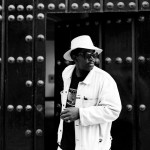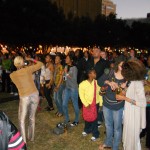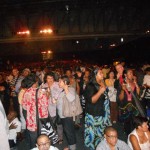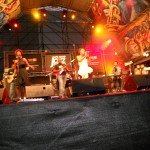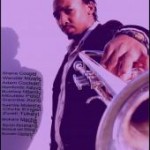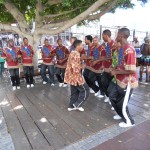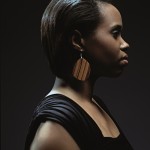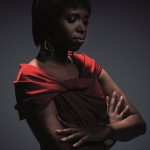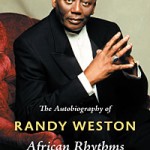In part one (scroll down or check the archives) of our lively conversation with Fab 5 Freddy, the graffiti artist who was one of the pioneers of what has become the global pop phenomenon known as hip hop we discussed the heavy jazz influence on young Fred’s Brooklyn upbringing, which included the significant influence of his godfather NEA Jazz Master Max Roach. One course correction: the crib Fab described in pt. 1 as Max Roach’s home on Gates Avenue, where Max, his dad Freddy Brathwaite, Sr. and other Brooklyn jazz heads, chess players and advanced thinkers would gather for their jazz “sets” was actually rented by Fab’s dad and several members of his crew as a kind of hipster’s clubhouse. “It was not Max’s but he was surely there often,” Fab corrected. “It was known as and always referred to as 212 Gates Avenue.” In part two we explore the continuing influence of Max Roach and his encouragement of Fab’s early forays into what was then known as “rap” music and has become the broader global phenomenon known as hip hop.
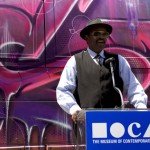
WJ: Is it safe to say that some of Max’s early consciousness of what was going on in early hip hop culture came from you?
Fab: Oh yeah. One day Max came to visit my dad and asked what I’m into and my dad said ‘oh, he’s into some rapping thing.’ This was before [hip hop] blew up, this was the early 80s when we were having street block parties and what not [in Brooklyn]. I was already making my moves on the arts scene and I was never trying to be a rapper but I had a few rhymes that I could get on the mic at a block party and do my thing. There was a DJ across the street who had built a nice system in his crib so I would go over there and rap a little bit. So my dad was aware of this, unbeknownst to me; my father was never into much contemporary music – with the exception of James Brown.
So one day I came home and my father said Max had been there and “I told him you’ve been doing this rap thing with your man across the street…” Right away I get kind of nervous because I never at that point considered anything music with the developing rap scene. I knew we weren’t playing instruments, we were making sounds and we were energetic and I knew this was a new thing that I dived into full speed ahead, but I didn’t consider it music — as in musicians. My father said ‘Max wants to check it out’, so I said OK. So we arranged a time a week or two later and he came through, on my block on Hancock Street between Lewis and Sumner [Brooklyn] – which is now Marcus Garvey Blvd… which is very appropriate.
I prepped my DJ and we worked out a little routine. Once again the music is not formulated – the four-minute rap song is not developed, it’s just an in the streets equivalent to just jamming, no real structure. Max comes by and I’m rhyming and my DJ is cutting up, he’s scratching… Max just peeped it. We did a little 20-minute thing and when we’re walking back to the house I’m thinking ‘what the hell is Max gonna think of this shit?’ Max said “Let me tell you guys something, that shit that you and your man were doing was as incredible as anything that me, Bird, Dizzy and any of us were doing…’ I’m thinking to myself [skeptically], ‘that’s so nice, trying to placate a young teenager…’ But that’s how Max was, always very encouraging, but I’m thinking to myself ‘yeah, right…’ Because I’m not seeing this as music, this hip hop thing…
“Rapper’s Delight” was probably out as a big record at that point, nothing really breaking crazy like it is now. It wasn’t long after that through me now making moves on the art scene and people knowing that I’m doing my thing on the downtown scene in New York, graffiti, introducing people to the beginnings of this hip hop culture, that a guy who promotes a lot of things with performance artists says ‘man, I found out that Max Roach is your godfather… We were talking with him about his M’Boom group…’ And he says, ‘man I feel like why don’t you do something with Max together…’ And I’m like thinking ‘huh, how the hell…?’ Next thing I knew Max says “yeah, let’s do it…” So then I started to have these conversations with Max, and Max says “yeah, you’re in charge, put this stuff together…”
This is the kind of enthusiasm he had and how eager they were to check out something new, which is the point Max made to me. He explained how Bird and the guys were about checking out new things, about how when Olatunji came around and they all jumped into the African thing and they were the first [generation] to take African names. He was saying this also to explain how a lot of cats wanted him to continue playing the stuff that they architected back in the 40s and 50s, but Max was always saying ‘I’m always about checking out that new thing…’ Obviously Max was able to put that in full effect. Max had hipped Miles to my show “Yo MTV Raps” and [Miles] was checking it out. This was an extension of how Max would always bring me up when the hip hop thing came up.
Another key thing that Max said to me after I gave him that demonstration with DJ Spy, Max said “…you know western music has for a long period of time been a balancing of three different things: melody, harmony and rhythm in equal ways. As black folks have been involved in music we’ve added an increasing emphasis on the rhythm element throughout the development of this music.” And Max, when he would have a conversation like that would always say “…from Louis Armstrong up until…” He said “what you guys are doing is just totally rhythm…” Now that’s one thing that when he broke it down I said “…oh shit, yeah…” just grabbing a piece of the music and having a way to manually manipulate the record to have this extended rhythm was something Max heard clearly. He also told me “man, if you don’t know it, this is so big what you guys are doing…” I’m like “yeah Max, great…” [still skeptical].
It was the early 80s when I had this conversation with Max. By 1988 I’m the host of the first nationally televised show to focus on this rap music [“Yo MTV Raps”] and go around the country interviewing the different people who were defining this culture – everybody from Tupac and Snoop to Will Smith and Run D.M.C., etc., etc. It would all become so much bigger than I ever, ever could have imagined… I’m talking like on a global basis – where people who speak other languages could adopt this thing and make it theirs in a unique way. I thought back to what Max had said and how he was right, and how when we get into it we were just gonna embrace this whole rhythm thing, and how just the verbal, this whole rapping thing was interesting.
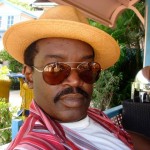
At what point did the light go on and you realized that this was part of a continuum – that what your father and Max and those guys were into… there was a straight-line continuum to what you and your contemporaries were getting into in the 80s?
Fab: It was during that time that it blew up. I’m hosting “Yo MTV Raps,” which just came out of nowhere, that was never an intention of mine to be on camera doing things… I always wanted to do things culturally to help stir it up and create these bigger platforms. A lot of my ability and understanding of that were things that I absorbed around my dad and his friends; knowing that Max Roach and these musicians were loved more so around the world than here… The fact that I knew people who were big in Paris, and Italy, and Japan was just amazing to me, it gave me a sense of the world as a very young kid.
Hence key things that I would make happen or launch or instigate in hip hop were motivated by these ideas – knowing that, wait a minute, this stuff that we’re doing in the ‘hood – in the Bronx or Brooklyn – is not happening anywhere else in the world. To me that was interesting and I knew it would be at least accepted in other places around the world because these people had embraced and understood the music we were making and put musicians like Max and them on a pedestal on a par with the greatest European musicians ever, and I felt that these people would at least appreciate the things we were doing, because at that time it was not in any way appreciated by mainstream culture here in America. And that led me to then do things which would become very significant.
The first film on hip hop culture, “Wild Style,” I starred in, I did all the music for, I collaborated with a guy named Charlie Ahearn on the film. The initial idea I had was to make a film that showed that there was a link between this music, this rapping and DJ’ing, this break dancing and this graffiti art… there were no links [established previously]. I felt that they were all very similar and if we could put it together in a movie, in a story that depicted it as such, it would create a much more cohesive cultural picture and a look at what we were doing in the streets and the ghettos of New York. There was no positive press or mentions of a young kid with sneakers on and his hat to the side… you were made to look like you were one of those criminals that was destroying the city. So “Wild Style” the movie became this first look that many people around the world had and a spark that ignited them to get busy, and I’m proud of that. Those ideas came directly from the experiences I had being around those kind of individuals [like Max Roach] and knowing that they made global moves.
OK, so you were sitting around as a young kid doing your thing and these elders were doing their thing, what was it about what you heard or experienced from these jazzheads that inspired you?
Fab: Jimmy Gittins had a huge influence on a lot of that because he was an artist, he was a sculptor and he started this program called the Sculpture Workshop that was a community organization that you could work as a kid and teach people sculpture in the Bed-Stuy area, and Jimmy just loved doing that. So these are my beginnings… taking a big chunk of clay and seeing Jimmy carve busts of Malcolm, and King Tut, and just making amazing images of us and things. And then me making something and anything I did Jimmy and all those guys were just encouraging and enthusiastic about. There was no idea or no kind of thing that was beyond at least discussing in my household. Not so much with my father, but Jimmy and those guys that were kind of an extension of [his dad].
It was Jimmy who taught me how to play chess when I was 8 or 9 years old. I felt like their little think tank if you will. They were just the most intelligent men… they were very articulate, they were very hip, they were very slick, they were street, all these things and I guess as those things synthesized in me it was just how I thought. It wasn’t always apparent how connected these thoughts were to what I grew up around, but as I grew older I would realize… and I would constantly think of what I was around as a kid and realize what effect these things had on me. Just knowing that Max was there…
I can remember when I first began to put two and two together and to figure out what I wanted to be a part of, which was the mainstream pop art world, where there was no real precedent of black folks being key in those spaces. It was really like ‘how do I do this…?’ I wanted to be a painter, like the work of Andy Warhol that I had seen as a little kid in a magazine; he looked cool to me… I would find some stuff that inspired graffiti artists, a lot of us that were painting on the trains. So what’s the difference? We’re getting stuff from comic books and ads just like they did, so what’s the difference? I just had to figure out a way to get into the galleries so that people could see me on the same walls they would see a Warhol or [Roy] Lichtenstein and what not.
Through this whole period whenever I would have meetings with Max I would download all this stuff and he would be so encouraging and enthusiastic. The first [art] show that we had, the first press, was at a real prestigious gallery in Rome in ’79. I’m like 19 or 20… it’s crazy!
How did you and Max Roach come to collaborate onstage?
Fab: This story I told you about earlier where the guy put us together, that happened at The Kitchen [NYC]. If you go on YouTube you can find a little clip of it, just a piece of it. I’m like, ‘I’m no musician’ and Max Roach was one of the biggest figures in my life, he’s a musician, how do I even talk music with him? I’m not a musician, but I could make sounds with my mouth. I was so nervous about giving Max instructions, like how do you tell this great master musician how and what to play? I remember at one point we had a conversation after we were rehearsing some stuff. He said “man listen, I know its kind of difficult for you to be able to tell me what to play, but man don’t even worry about that, you’re in charge.” It was unbelievable that he would say some shit like that! I’d have to get my shit together and then figure out how to express it to him.
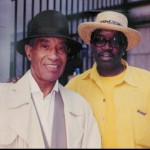
Max & Fab
There’s a recording that I’ll dig up, one of the things that we recorded and I wrote a rap… It was hard for me to instruct Max how to keep like one beat as simply as the backbeat for any one of a million rap records that have been made since then. How do you tell a guy that plays the drums and makes it sound like there are three people playing at once… I don’t even know how to do that, it just seemed awkward. What I thought about doing, which we did and I found a recording of that – and this was before sampling was a big thing – I said “what we’ll do is we’ll record and then we’ll loop a recording of what I hear from what you played and I’ll get the engineers to loop that up and make a track of that, and from that track I made a rap over that: “Max Roach he’s architect, a pioneer, on the drums he’s an architect, an engineer…” I had fly shit that I just wrote about Max. When I played it back recently I was like “Oh my God, that’s nice… yeah!” But once again it was just unstructured, because the whole song structure [of rap] hadn’t developed and it was just me rapping and Max playing. I think it had a hook and it would have been very interesting had we released it.
It’s hip hop in the sense that… Hip hop is more like… I mean people call Kenny G jazz, but you would have a problem saying that, right?
Yep.
Fab: Good, me too. Along that line we could differentiate between, like Blondie, something else that I helped make happen, Deborah Harry making “Rapture”, which was the first rap record to go #1 pop. She’s rapping, but that’s not hip hop. Hip hop bespeaks many things, particularly being part of the culture, adhering to all those things that are just… You know what I’m saying? Like there’s white cats… not to dismiss Kenny G because he’s white, but there’s Gene Krupa, there are a lotta white dudes that you could just feel by how they articulate what they do on their instrument… you’re like ‘OK, dude gets a pass…’
I used to love hearing my father and them listening when I was a young boy… ‘Aw man no, that’s so and so, no that’s not him,, that sounds like blah, blah, blah… no, that’s an ofay…’ They weren’t dissin’ white people, but it really meant most of the time that they weren’t as up to snuff as most of the official cats. I know that Gene Krupa got some love and there were some white musicians that my father and them would okay, but not that many…
What we did you could say it was hip hop, but yeah I was just rappin’, because it’s me, because anything I do is officially hip hop because I’m one of the creators of the brand and what not [laughs].
One of the things that Max always said about the development of rapping and eventually hip hop culture relates to yours being the first generation that was denied the opportunity to pick up any instrument they wanted to learn in school; and as a result your generation created rap and hip hop out of raw materials.
Fab: Great point, key point… Yes Max would bring that up, that instruments are gone from the schools… Its funny, I do a lot of work with VH1 and they have this big initiative called “Save the Music” which is a big charitable initiative where they raise all this money to put instruments back in the schools because kids from this generation are not aware for many generations that [the availability of instruments to learn in public schools] was a standard thing in schools, almost a requisite. So you’re right, Max and them would speak to that. It is in a roundabout way one of the things that gives birth to hip hop, this form, this new thing was because kids were not able to develop and become proficient on instruments like many would have wanted to or would have dabbled in to a certain extent. That would be a discussion we would have with Max. He was very aware of things going on as they connected to a historical lineage. A lot of this shit didn’t click then, but I’m glad I remembered it because it all fit into place as the years went by.
